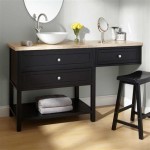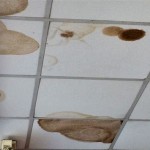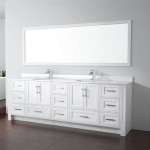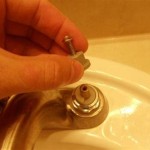Bathroom Sink Caulk Strip: An Essential Guide to Selection, Application, and Maintenance
The bathroom sink is an area prone to water exposure, making it a breeding ground for mold and mildew. A properly installed and maintained caulk strip is a critical component in preventing water damage and maintaining a hygienic and aesthetically pleasing bathroom environment. This article provides a comprehensive overview of bathroom sink caulk strips, including their purpose, types, selection criteria, application techniques, and essential maintenance practices.
Caulk, in its various forms, acts as a sealant, filling gaps and creating a waterproof barrier. Around bathroom sinks, it prevents water from seeping behind the sink, into the wall, or onto the floor. This is especially important in preventing structural damage and the growth of harmful microorganisms. A failing caulk strip can lead to significant problems, including drywall damage, wood rot, and the proliferation of mold and mildew, which can pose health risks.
The primary function of a caulk strip is to create a watertight seal between the sink and the countertop or wall. This seal prevents water from entering the spaces where it can cause damage. Beyond its functional role, a caulk strip also contributes to the overall aesthetic of the bathroom. A clean, well-maintained caulk line provides a finished and professional appearance, enhancing the visual appeal of the sink area.
Understanding Different Types of Caulk for Bathroom Sinks
Several types of caulk are suitable for use around bathroom sinks, each with its own set of properties and advantages. Understanding these differences is crucial for selecting the best option for a specific situation.
Acrylic Caulk: Acrylic caulk is a water-based sealant known for its ease of application and cleanup. It is generally less expensive than other types of caulk, making it a budget-friendly option. Acrylic caulk is paintable, allowing for customization to match the surrounding décor. However, it is less flexible and durable compared to silicone caulk, and it may be more prone to cracking or shrinking over time. Acrylic caulk is generally best suited for areas with minimal exposure to water and moderate temperature fluctuations.
Latex Caulk: Latex caulk shares many similarities with acrylic caulk, being water-based and easy to apply. It also offers good adhesion and paintability. However, like acrylic caulk, latex caulk is not as flexible or water-resistant as silicone caulk. While it provides a decent seal, it is not ideal for areas with high water exposure or significant movement. Latex caulk is suitable for filling gaps and cracks in areas that are not constantly exposed to moisture.
Silicone Caulk: Silicone caulk is a synthetic sealant known for its superior flexibility, durability, and water resistance. It is highly effective at creating a watertight seal and can withstand significant temperature fluctuations and movement without cracking or shrinking. Silicone caulk is available in various colors and formulations, including mildew-resistant options specifically designed for bathrooms. However, silicone caulk is more difficult to apply and clean up compared to acrylic or latex caulk. It is also not paintable, requiring careful color matching during selection. Silicone caulk is the preferred choice for areas with high water exposure, such as around bathroom sinks and showers.
Acrylic Latex Caulk with Silicone: This type of caulk combines the benefits of both acrylic latex and silicone. It offers improved flexibility and water resistance compared to standard acrylic latex caulk while maintaining ease of application and paintability. This hybrid caulk provides a good balance of performance and convenience, making it a versatile option for various bathroom applications. It is generally more expensive than pure acrylic latex caulk but less expensive than pure silicone caulk.
Polyurethane Caulk: Polyurethane caulk is a highly durable and flexible sealant known for its excellent adhesion and resistance to chemicals and solvents. It is often used in demanding applications where a strong and long-lasting seal is required. While polyurethane caulk offers superior performance, it is more difficult to work with and requires specialized tools and techniques for proper application. It is also more expensive than other types of caulk. Polyurethane caulk is generally reserved for specialized applications and is not typically used for standard bathroom sink caulking.
Key Considerations for Selecting the Right Caulk Strip
Choosing the appropriate caulk strip involves considering several factors to ensure optimal performance and longevity. These factors include water exposure, movement, aesthetics, and ease of application.
Water Exposure: The level of water exposure is a primary consideration. For areas with high water exposure, such as around the sink basin and faucet, silicone caulk is the preferred choice due to its superior water resistance. For areas with minimal water exposure, such as along the back of the countertop, acrylic or latex caulk may be sufficient.
Movement: The amount of movement between the sink and the countertop or wall is another important factor. If there is significant movement, such as in older homes or areas with unstable foundations, a flexible caulk, such as silicone or acrylic latex with silicone, is essential to prevent cracking and maintain a watertight seal.
Aesthetics: The color and finish of the caulk should complement the surrounding décor. Caulk is available in a wide range of colors, including white, clear, and various shades of gray and beige. It is important to select a color that blends seamlessly with the sink, countertop, and wall. Paintable caulk, such as acrylic or latex, offers the flexibility to customize the color to match the surrounding surfaces.
Mold and Mildew Resistance: Bathrooms are prone to mold and mildew growth, making it essential to choose a caulk that is specifically formulated to resist these microorganisms. Look for caulk that is labeled as "mildew-resistant" or "anti-microbial." These caulks contain additives that inhibit the growth of mold and mildew, helping to maintain a clean and hygienic environment.
Ease of Application: The ease of application is an important consideration, especially for DIY projects. Acrylic and latex caulks are generally easier to apply and clean up compared to silicone caulk. Silicone caulk requires more precise application and may require specialized tools and techniques. Choosing a caulk that is easy to work with can significantly improve the outcome of the project.
Proper Application Techniques for a Lasting Caulk Seal
Applying caulk correctly is crucial for achieving a watertight seal and preventing water damage. Proper surface preparation, caulk application, and finishing techniques are essential for a successful outcome.
Surface Preparation: Thorough surface preparation is critical for ensuring proper adhesion. Begin by removing any old caulk, dirt, grease, or mildew from the surfaces to be caulked. Use a caulk removal tool or a sharp utility knife to carefully scrape away the old caulk. Clean the surfaces with a mild detergent and water, and then rinse thoroughly. Allow the surfaces to dry completely before applying the new caulk. A dry surface is essential for proper adhesion.
Applying the Caulk: Load the caulk tube into a caulk gun. Cut the tip of the caulk tube at a 45-degree angle, making the opening slightly smaller than the width of the gap to be filled. Apply a steady, even bead of caulk along the joint between the sink and the countertop or wall. Maintain a consistent pressure on the caulk gun to ensure a uniform bead. Avoid applying too much caulk at once, as this can make it difficult to smooth and clean up.
Smoothing the Caulk: After applying the caulk, use a wet finger or a caulk smoothing tool to create a smooth, concave finish. Dip your finger or the smoothing tool in water with a drop of dish soap to prevent the caulk from sticking. Run your finger or the tool along the bead of caulk, applying gentle pressure to smooth it out and remove any excess caulk. Wipe away any excess caulk with a damp cloth or paper towel.
Curing Time: Allow the caulk to cure completely before exposing it to water. Curing time varies depending on the type of caulk and the humidity levels. Refer to the manufacturer's instructions for the recommended curing time. Generally, it is best to wait at least 24 hours before using the sink after applying caulk.
Essential Maintenance Practices for Bathroom Sink Caulk Strips
Regular maintenance is essential for prolonging the life of the caulk strip and preventing water damage. Proper cleaning, inspection, and repair are crucial for maintaining a healthy and aesthetically pleasing bathroom environment.
Regular Cleaning: Clean the caulk strip regularly with a mild detergent and water to remove dirt, soap scum, and mildew. Use a soft brush or sponge to scrub the caulk gently. Avoid using abrasive cleaners or harsh chemicals, as these can damage the caulk. Rinse thoroughly with water and dry with a clean cloth.
Inspection: Inspect the caulk strip regularly for signs of damage, such as cracks, gaps, or mildew growth. Pay close attention to areas that are frequently exposed to water. If you notice any damage, repair or replace the caulk strip promptly to prevent water from seeping behind the sink.
Repairing Minor Damage: Minor cracks or gaps in the caulk strip can often be repaired with a small amount of fresh caulk. Clean the damaged area thoroughly and apply a thin bead of caulk to fill the cracks or gaps. Smooth the caulk with a wet finger or a caulk smoothing tool, and allow it to cure completely before exposing it to water.
Replacing Damaged Caulk: If the caulk strip is severely damaged, such as with large cracks, significant mildew growth, or loss of adhesion, it is best to replace it entirely. Remove the old caulk using a caulk removal tool or a sharp utility knife. Clean the surfaces thoroughly and apply a fresh bead of caulk using the proper application techniques. Allow the caulk to cure completely before using the sink.
By understanding the different types of caulk, selecting the right option for a specific application, using proper application techniques, and implementing regular maintenance practices, homeowners can ensure a long-lasting and effective caulk seal around their bathroom sinks, preventing water damage and maintaining a hygienic and aesthetically pleasing bathroom environment. Regular attention to the caulk strip is a small investment that can save significant time and money in the long run by preventing costly water damage and mold remediation.

Bathroom Kitchen Accessories Shower Bathtub Seal Tape Caulk Strip Self Adhesive Waterproof Wall Sticker Sink Edge Fruugo Nl

Bathroom Shower Sink Bath Sealing Strip Tape White Pvc Self Adhesive Waterproof Wall Sticker For Bathtub Toilet Caulk Pe Decorative Used Kitchen

Mildew Proof Waterproof Sink Caulk Strip Sealing Tape Kitchen Bathroom Toilet

4 Packs Caulk Strip Tape 10 5ft X 1 5in Self Adhesive Caulking Sealing For Kitchen Bathroom Sink Bathtub Toilet And Floor Wall Edge Protector With Tool Com

Waterproof Anti Mildew Toilet Caulk Strip Self Adhesive Sealing Tape For Kitchen Bathroom To Avoid Wet Sink Beautiful Seam Stickers Temu

Kitchen Bathroom Self Adhesive Sealing Tape Waterproof Sink Caulk Strip Corner

1 Pack Waterproof Pvc Caulk Strip Tape Self Adhesive Sealing For Kitchen Bathroom Toilet Sink Wall 10 5 Feet Inches Tika Com

Tape Caulk Strip Pvc Self Adhesive Caulking Sealing For Kitchen Sink Toilet Bathroom Shower And Bathtub China Made In Com

Bathtub Wall Sealing Caulk Strip Pe Self Adhesive Waterproof Tape Sealer Decorative Trim For Kitchen Bathroom Shower Toilet Corner 38mm Muebles Para Baños Pequeños Decoración De Baño

Kitchen Bathroom Sink Caulk Strip Seal Tape Self Adhesive Waterproof Home
Related Posts







